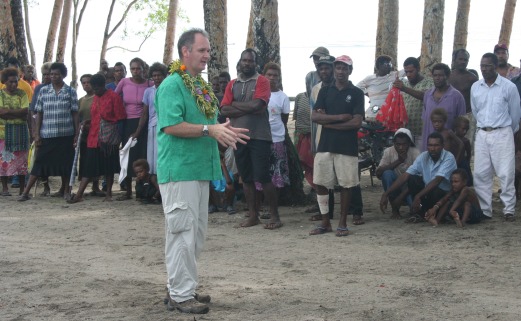19 June 2013
Helping Temotu Build Back Better
What were you doing 127 days ago? You would probably need to check your diary to see what you were doing at 12.12pm on Wednesday, 6 February, when an 8.0 earthquake, followed by a localised tsunami terrorised the population of the Santa Cruz islands, in the far east of Solomon Islands.
If I gave you a crow bar, a shovel, a hammer, a bag of nails and a machete, could you rebuild your life?
What if I threw in some rice, a bucket and some second hand clothing?
Could you live in the same set of clothes for 127 days? How long could you sleep under the same tarpaulin with your five children?
Let’s add in some rainfall from a few passing tropical depressions. It has been the wet season after all. Catch what water you can in your bucket to wash your kids and prepare food. But don’t let the water stagnate; there’s been a dengue outbreak in Solomon Islands.
How many times have you been down to your local shops in the past 127 days to stock up the pantry? Or the ATM to get some cash?
In the world of 24 hours news cycles, sound bites and media grabs, it’s all too easy to move from one crisis to the next – all it takes is a flick of a button on a television remote control.
Typically, natural disasters are over in minutes, but for those affected, they resonate for a lifetime.
I went back in Lata, in Temotu Province last month and was struck by how much has been achieved since February’s earthquake and tsunami. But I was also reminded of how far there is to go to give these beautiful people a chance to start over.
Seasoned humanitarians, like AusAID’s Sid Chakrabarti who travelled with me, are right to remind me – and often - that moving from the relief to recovery phase will take twice as long as the best estimates.
But all the while, those who have lost everything – and according to Solomon Islands Red Cross figures, 6589 people were affected, in 1598 households and from 85 communities – are still living under tarpaulins, sending their kids to tented classrooms and worrying about the gardens, their businesses and next year’s school fees.
During my most recent visit, the people of Temotu were extraordinarily grateful for Australia’s assistance, along with that from the wider donor community, as well as their own Government.

Speaking to the community at Venga Village, Temotu Province.
But they didn’t ask me for much.
Harriet Bade, on behalf of the women from Venga village simply asked for a sewing machine to fix the donated clothes – amazingly, she wasn’t asking for more clothes. Just the means to fix the donated clothes they wore. And, on behalf of the mothers, could we make rebuilding the schools a priority?
In an emotional address, Allen Lvirner, also from Venga, said there were plenty of bush materials, however, they need nails if they are to rebuild their community on higher ground. And a hammer. He had worn his out.
The only other thing both Harriet and Allen asked was for Australia to remain engaged, and to take the message back to Honiara that, while thankful, they still needed help.
Our support of SBD$7.5 million (A$1 million) helped the government and NGOs to respond to the Temotu disaster. And this support continues. Like AusAID working with the Ministry of Education to help rebuild destroyed or damaged schools to ‘build back better’. But there is still much to do.
I reminded the people of Temotu that Australia is not a fair weather friend. We’re partners. While there is a need, we will remain engaged. And we will.
Matt Anderson
Australian High Commissioner to Solomon Islands
